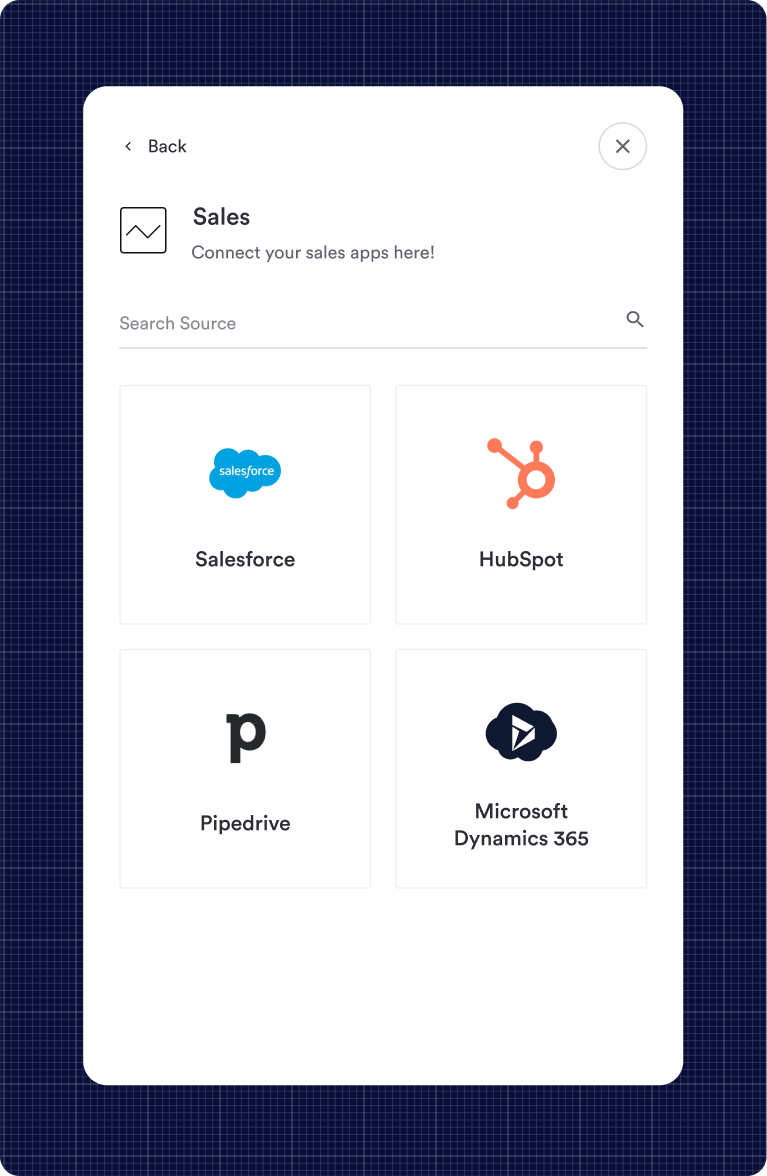
QuickBooks Integration With Unified API Schema and Embedded iPaaS
Enable users to connect their QuickBooks data to your product in minutes, without querying the QuickBooks API yourself.
Create a QuickBooks integration in minutes
STEP 1
Select QuickBooks as a source

Cherry-pick the QuickBooks data you need from the QuickBooks connector
STEP 2
Format the data
Deploy simple Python scripts to fit the QuickBooks data to your schema
STEP 3
Select your destination



Send the user data directly to your backend

QuickBooks data
Access all the objects and custom fields the QuickBooks API offers
Invoice
FIELDS
AllowIPNPayment, AllowOnlinePayment, AllowOnlineCreditCardPayment, AllowOnlineACHPayment, Id, MetaData, CustomField, DocNu...
Bill
FIELDS
Id, VendorRef, Line, CurrencyRef, TxnDate, APAccountRef, SalesTermRef, LinkedTxn, TotalAmt, DueDate, MetaData, DocNumber, ...
SalesReceipt
FIELDS
Id, MetaData, CustomField, DocNumber, TxnDate, CurrencyRef, CustomerRef, Line, FreeFormAddress, ShipFromAddr, TotalAmt, Ap...
Account
FIELDS
Name, SubAccount, Description, FullyQualifiedName, Active, Classification, AccountType, AccountSubType, AcctNum, CurrentBa...
Customer
FIELDS
Taxable, BillAddr, ShipAddr, Job, BillWithParent, Balance, BalanceWithJobs, CurrencyRef, PreferredDeliveryMethod, IsProjec...
Item
FIELDS
Name, Active, FullyQualifiedName, Taxable, UnitPrice, Type, IncomeAccountRef, PurchaseCost, TrackQtyOnHand, Id, MetaData, ...
CreditMemo
FIELDS
RemainingCredit, Id, MetaData, CustomField, DocNumber, TxnDate, CurrencyRef, CustomerRef, ClassRef, Line, CustomerMemo, To...
JournalEntry
FIELDS
Adjustment, TotalAmt, HomeTotalAmt, Id, MetaData, DocNumber, TxnDate, CurrencyRef, ExchangeRate, Line
Purchase
FIELDS
PrivateNote, PaymentType, MetaData, RemitToAddr, CurrencyRef, ExchangeRate, TotalAmt, PrintStatus, AccountRef, Id, EntityR...
TimeActivity
FIELDS
HourlyRate, CustomerRef, Taxable, Description, Minutes, MetaData, ItemRef, Id, domain, TxnDate, EmployeeRef, BillableStatu...
ProfitAndLossDetailReport
FIELDS
Date, TransactionType, Num, Name, Memo, Split, Class, Amount, Balance, Categories
GeneralLedgerReport
FIELDS
Date, TransactionType, Num, Name, Memo, Split, Class, Amount, Balance, Categories
TransactionListReport
FIELDS
Date, TransactionType, Num, Posting, Name, Memo, Account, Split, Class, Amount, Categories
CashFlowReport
FIELDS
Total, Account, Categories
BalanceSheetReport
FIELDS
Total, Account, Categories
Vendor
FIELDS
Id, DisplayName, PrintOnCheckName, MetaData, sparse, Active, Balance
Employee
FIELDS
Id, DisplayName, PrintOnCheckName, MetaData, BillableTime, HiredDate, domain, sparse, PrimaryAddr, GivenName, FamilyName, ...
Build integrations your customers will love
Offer your next SaaS integration in four simple steps.
1. Choose source
Select the data you need from our library of connectors.
Browse our connectors.2. Format the data
Use our standard schemas, or develop custom mapping scripts so data comes in how you want it.
Browse our standard schemas.3. Choose target
Receive new data directly in your backend via database, filestore, API, and more.
4. Embed hotglue
Our embeddable components give customers an intuitive way to link their accounts.
Read more in the docs.
Manage integrations at scale
Maintain visibility into your integration workflows with detailed job logs, reporting, and real-time alerting baked in.
Secure and compliant
Built with security and compliance in mind.
SOC 2 Type II certified
Scalable cloud infrastructure
GDPR compliant (DPA available by request)
Ready to build your next integration?
Build native integrations with the platforms your customers use 10x faster.

